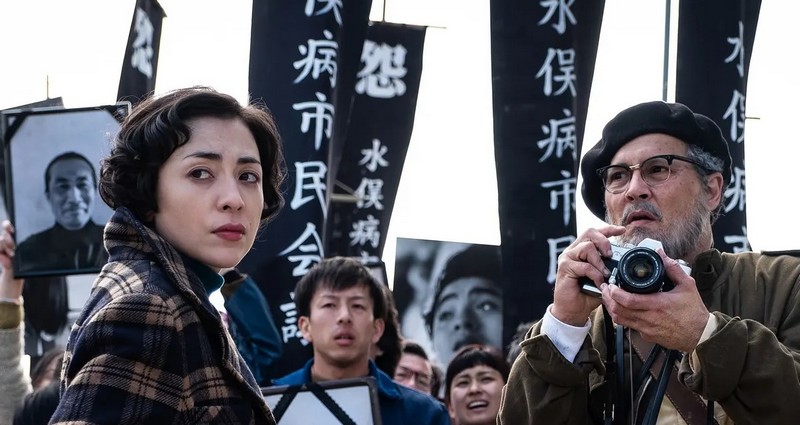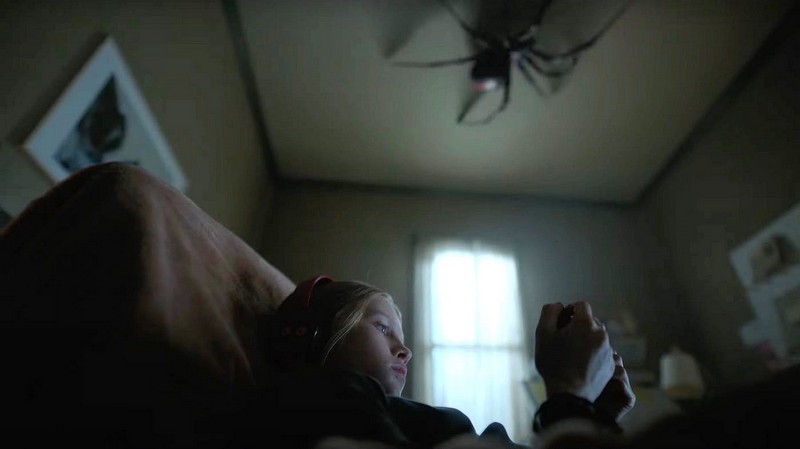Based on a true story this drama about industrial pollution and environmental damage caused by giant chemical companies. Minamata explores their greed, corruption and refusal to accept responsibility or take action. This puts the film in the same wheelhouse as films like Erin Brokovich and Dark Waters, although it is nowhere near as provocative or compelling.

Minamata is a small waterfront town in Japan. For fifteen years, since the late 50s, the Chisso chemical corporation had been pouring massive amounts of mercury into the local waterways. The local community relied on fish and fishing for much of their livelihood and lifestyle, but the waters and food were being poisoned. People were suffering convulsions and crippling deformities. The company knew what was happening, but apart from setting up a hospital to tend to the sick, had done nothing about the problem. This was one of the worst industrial pollution incidents in Japan’s history.
The whole horrible scenario came to light after American photographer W Eugene Smith (played here by Johnny Depp) had photographed the area and highlighted some of these issues. A former war photographer Smith had been “the greatest photographer that LIFE magazine ever had”, in his own words, and had photographed many of the world’s hot spots. But his career was nearing its end. Haunted by his vivid memories of the horrors of war he was addicted to pills and alcohol and had burned too many bridges with LIFE’s editor Robert Hayes (Bill Nighy). In his own words he always found a way to “disappoint people.”
While preparing an exhibition of his work for a New York gallery, Smith was approached by Aileen Mioko (Minami, from Battle Royale), a Japanese translator who pricked his conscience about what was happening in her hometown and invited Smith to take a look. Smith convinced Hayes that this was a story worth pursuing. However, when he arrived in Japan he found that he was an outsider and found it hard to break down the barriers and earn the people’s trust. Many of the locals didn’t want to be photographed, and other feared reprisals from the powerful Chisso corporation. But, with the support of Aileen and her family and a few like-minded activists within the community, Smith slowly earned their trust. He even befriended a deformed crippled teenage boy who had an interest in photography.
The Chisso company however tried to dissuade Smith, by offering him a bribe and, when that failed, they burned down his makeshift photography studio. He was even badly beaten during a riot during the annual Chisso stockholders’ meeting.
Fittingly, Minamata is dedicated to those “victims of industrial pollution around the world.” Over the end credits we get to see many of the actual photographs taken by Smith, which effectively illustrate the horrific consequences of Chisso’s actions. These include the famous and intimate image of “Tomoko Uemura in her Bath”, which has been named one of the most important journalistic photographs of the century because of how much it conveys of the pain and damage caused by Chisso’s reckless actions.
The film is based on the 1975 book written by Smith and Mioko. Minamata was something of a passion project for Depp, who is attached to the film as one of the producers. He has eschewed his usual boyish looks to play Smith, using grey hair and beards and spots on his skin to play the older Smith, and he also gives him a weary and haunted look that suits the cynical character. Nighy brings his usual phlegmatic quality to his small role as Hayes. Veteran Japanese actor Jun Kunimura (the recent Midway) is solid as Junichi Nojima, the cold and stoic but corrupt and powerful chair of the Chisso corporation.
This is the sophomore feature for director Andrew Levitas (the financial drama Arbitrage), who has established a formidable reputation across many disciplines including sculpture, photography and film. Minamata was largely shot on location in Japan and has something of the look and feel of classic Japanese cinema about it. Oscar winning cinematographer Benoit Delhomme has captured some striking imagery here.
Greg King
Other reviews you might enjoy:

Greg King has had a life long love of films. He has been reviewing popular films for over 15 years. Since 1994, he has been the film reviewer for BEAT magazine. His reviews have also appeared in the Herald Sun newspaper, S-Press, Stage Whispers, and a number of other magazines, newspapers and web sites. Greg contributes to The Blurb on film





